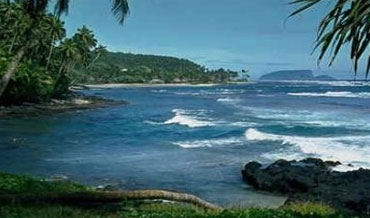Guinea: Guinea Environment Profile
2012/03/13

Guinea Environment Profile The coastal region of Guinea and most of the inland have a tropical climate, with a rainy season lasting from April to November, relatively high and uniform temperatures, and high humidity. Conakry's year-round average high is 29 °C (84.2 °F), and the low is 23 °C (73.4 °F), its average annual rainfall is 4,300 mm (169.3 in). Sahelian Upper Guinea has a shorter rainy season and greater daily temperature variations.
Biosphere Reserves Guinea
Mount Nimba (1980)
- Mount Nimba Strict Nature Reserve is a national park and UNESCO World Heritage Site in both Guinea and Côte d'Ivoire. A further extension of the reserve to include areas in Liberia hastreahs also been proposed. The park includes significant portions of Mount Nimba, a geographically unique area with more than 200 endemic species. These species include multiple types of duikers, big cats, civets, Chimpanzees, and several types of viviparous toads.
The nearest major settlements are the town Yekepa to the west in Liberia and Bossou in Guinea Massif du Ziama (1980)
Haut Niger
-
The National Park of Upper Niger is a recently gazetted national park in Guinea in northwestern Africa. The park covers around 6000 square km of in the north-eastern area of the country, of which 600 square km comprise the core area. The park protects important tracts of forest and savannah, and is considered a conservation priority for West Africa as a whole.
- History: Areas of low human impact are comparatively rare now in Guinea, and found only in areas of low population density. One such area is that of the Mafou Forest, the last remaining area of dry forest in Guinea and one of the few left in West Africa. This area has a low population because of the widespread incidences of river-blindness and as a result of the atrocities of Samory Touré in the latter part of the 19th century. The area has been little disturbed in the last 50 years. The park comprises two zones, a core protected zone and a buffer zone in which local people are encouraged to use the resources of the part in a sustainable way. Farming and the collecting of non-timber forest products is permitted. The government manages fishing, hunting and timber harvesting in cooperation with local communities.
- Ecology of the park : The park covers several ecological zones, the dominant is that of savannah, comprising of woodland and bushland. A smaller area of the park consists of riparian forests along the Niger and Mafou Rivers. Around five % of the park is agricultural, along the edges of the park. The park is subject to frequent fires during the dry season.
- Fauna of the park : Surveys of the park have shown a diverse mammalian and avian fauna. Over 94 species of mammals have been found in the park, and more can be inferred. Important species found in the park include Giant Pangolins, West African Chimpanzees, Gambian Mongooses (a rare, endemic species that seems to be well-represented in the park), Kob, and Spot-necked Otters. Lions and African Manatees have also recently been confirmed. The African Elephant once existed in the park but is currently extinct there.
- Threats to the park : There is a large trade in hunted animals from the park. At present this is carefully managed by park authorities, who feel that creating incentives for careful management of the resources is the best way to protect the forest as a whole. This is in line with current trends in community conservation.
- Massif du Ziama (1980)
- Badiar (2002)
- Guinea News
-
- GUINEA: Deadly Riots Again Grip Guinea’s Bauxite Hub
- CHINA: China to Loan Guinea US$20 Billion for Access to Bauxite Reserves
- CHINA: China to loan Guinea $20 billion to secure aluminum ore
- AFGHANISTAN: UNWTO: International tourism – strongest half-year results since 2010
- BOTSWANA: Why governments need to support the financial sector to meet the unserved needs of smallholder farmers
- BOTSWANA: International Arrivals To Africa Reach More Than 18 Million In 2017
- Trending Articles
-
- SOUTH AFRICA: Nigeria and South Africa emerge from recession
- BAHRAIN: Bahrain issues new rules to encourage fintech growth
- UZBEKISTAN: Former deputy PM named Uzbekistan Airways head
- ARUBA: Director of Tourism Turks and Caicos after Irma: Tourism, visitors, hotels current status
- ANGOLA: Angola: Elections / 2017 - Provisional Data Point Out Qualified Majority for MPLA
- WORLD: How fair is our food? Big companies take reins on sourcing schemes





.gif?1356023993)



